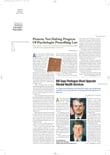What drives people who save newspapers, magazines, old clothing, bags, books and heaven knows what else? Or to phrase it more scientifically, what makes compulsive hoarders act as they do?
Sanjaoya Saxena, M.D., an associate professor of psychiatry at the University of California at Los Angeles, and his colleagues decided to conduct what appears to be the first study to answer this question. As they reported in the June American Journal of Psychiatry, compulsive hoarders exhibit a different pattern of brain glucose metabolism than do both normal comparison subjects and other types of obsessive-compulsive subjects.
Saxena and his coworkers performed PET scans on 45 adults who met DSM-IV criteria for obsessive-compulsive disorder, 12 of whom had compulsive hoarding as their most prominent obsessive-compulsive symptom, as well as on 17 healthy comparison subjects. All subjects had been free of psychotropic medications for at least four weeks. The researchers then compared glucose metabolism in the three groups of subjects.
Compared with the healthy control subjects, compulsive hoarders had significantly lower glucose metabolism in the posterior cingulate gyrus and cuneus, while the non-hoarding obsessive-compulsive subjects did not. Also, compulsive hoarders had significantly lower metabolism in the dorsal anterior cingulate gyrus than the other obsessive-compulsive subjects.
Thus, obsessive-compulsive hoarding may be a neurobiologically distinct subgroup or variant of obsessive-compulsive disorder whose symptoms are mediated by lower activity in the cingulate gyrus.
A commentary about the study in the same issue of the American Journal of Psychiatry stated, “Lower activity in both the anterior and posterior cingulate gyrus may help explain the decision-making, attentional, and other cognitive problems of compulsive hoarders.”
But how might lower metabolism in the posterior and anterior cingulate gyrus lead to hoarding? Functions of the anterior cingulate include motivation, executive control, and emotional self-control and decision making, especially in choosing between multiple conflicting options. The posterior cingulate is involved in activities such as monitoring of visual events, spatial orientation, episodic memory, and the processing of emotional stimuli.
“Thus, lower activity in both the anterior and posterior parts of the cingulate gyrus may mediate the remarkable difficulty in making decisions, attentional problems, and other cognitive deficits seen in compulsive hoarders,” Saxena and his colleagues suggested.
Saxena also told Psychiatric News, “These cognitive deficits may lead to hoarding and saving behaviors because patients cannot decide which items to keep and which ones to discard, so they simply keep everything. Compulsive hoarders also frequently procrastinate or are distracted from discarding or cleaning, so their clutter accumulates and grows over time.”
Lower activity in the anterior and posterior cingulate may not only mediate the symptoms of compulsive hoarding, but also its poor response to treatment, Saxena and coworkers pointed out in their study report. For instance, low activity in the anterior cingulate gyrus as well as in the posterior cingulate gyrus have been found to correlate with a poor response to antidepressant treatment in obsessive-compulsive subjects.
These results have implications for clinical psychiatrists, Saxena told Psychiatric News. “One major implication,” he said,“ is that compulsive hoarders appear to be neurobiologically different from other obsessive-compulsive disorder patients and, therefore, may require different treatment approaches that address their unique brain abnormalities (that is, low cingulate activity). Our results suggest that medications that increase cingulated cortex activity, such as stimulants or cognitive enhancers, may be helpful for compulsive hoarding.”
Saxena and his team are now trying to replicate and extend their findings in a new, larger study of brain structure, brain function, and neurocognitive functioning in compulsive hoarders versus nonhoarding obsessive-compulsive disorder patients and controls. “We are also planning to conduct treatment trials of new medications for compulsive hoarding, to test hypotheses generated by our brain imaging findings,” he said.
The study was financed by the National Institute of Mental Health, the Obsessive-Compulsive Foundation, the National Alliance for Research on Schizophrenia and Depression, a Veterans Affairs Type I Merit Review Award, the Tobacco-Related Disease Research Program, the Department of Energy, and Mr. and Mrs. Brian Harvey.
Am J Psychiatry 2004 161 1038
